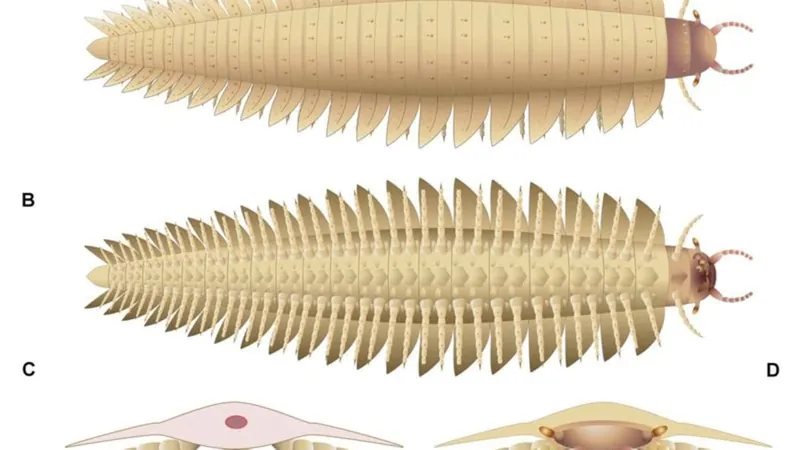
Discovery of Ancient Millipede Fossils Unveils Secrets of the Gigantic Arthropleura!
2024-10-10
Author: Wei
Groundbreaking Discovery
A groundbreaking discovery has unveiled two incredibly well-preserved fossils of *Arthropleura*, the colossal ancient millipede that once ruled the Earth during the Carboniferous Period, approximately 305 million years ago. This giant creature reached an astonishing length of up to 10 feet 6 inches (3.2 meters), making it the largest land arthropod known to date, inhabiting what we now recognize as North America and Europe.
Filling the Knowledge Gap
Previously, the scientific community faced a significant gap in understanding this magnificent creature due to the absence of well-preserved head fossils. Researchers recently unearthed these vital fossils in Montceau-les-Mines, France, which have significantly contributed to our knowledge by elucidating its anatomical structure. Contrary to assumptions that it may have been a fearsome predator, these new findings categorize *Arthropleura* as a herbivorous millipede, thriving on a diet of decaying plant matter.
The Carboniferous Environment
During the Carboniferous Period, Earth’s atmospheric oxygen levels were dramatically elevated, creating an environment that fostered incredible growth among plants and animals. At that time, Montceau-les-Mines was located near the equator, boasting a warm, swampy habitat abundant with vegetation – the perfect ecosystem for such an enormous creature.
Fossil Features and Anatomy
The newly discovered fossils reveal fascinating details. The specimens, identified as juvenile individuals only 1.5 inches (4 cm) in length, exhibit round, circular heads adorned with slender antennae, stalked eyes reminiscent of crab anatomy, and mandibles crafted for grasping food. Each specimen consisted of 24 body segments and an astounding 44 pairs of legs – a total of 88 legs that underline its classification as a slow-moving detritivore.
Paleontological Insights
Paleontologist Mickaël Lhéritier, leading the study published in Science Advances, compared *Arthropleura* to modern-day elephants or large dinosaurs, suggesting it played a similar ecological role—spending most of its time feeding. "Imagine it as the ‘cow’ of the Carboniferous, but with an exoskeleton and many more legs," Lhéritier remarked, expressing awe at the creature's immense size and gentle demeanor.
Evolutionary Relationships
The new anatomical evidence also reveals critical insights into the evolutionary relationship between millipedes and centipedes. While *Arthropleura* shares traits with both groups, its head structure indicates a unique blend of characteristics—further narrowing the genetic gap that separates them in the evolutionary timeline.
Giant Arthropods of the Era
The emergence of giant arthropods during this era is not isolated to *Arthropleura*. Other notable huge arthropods from the Carboniferous include *Meganeura*, an enormous dragonfly with a wingspan comparable to eagles, and *Pulmonoscorpius*, a scorpion measuring over 3 feet (1 meter) in length. Scientists attribute this astonishing size to two primary factors: heightened atmospheric oxygen levels and the abundant resources that arose as arthropods began to colonize land long before vertebrate life forms.
Conclusion and Future Research
As the fascination grows for the existence of these enormous ancient creatures, researchers continue to dig deeper into our planet’s distant past, exploring how these remarkable beings shaped the ecosystems of their time. The unearthing of *Arthropleura* not only enhances our understanding of evolutionary biology but also captivates our imagination about life on Earth when giants roamed freely. Will other thrilling discoveries like this emerge from the depths of our planet? Stay tuned!



 Brasil (PT)
Brasil (PT)
 Canada (EN)
Canada (EN)
 Chile (ES)
Chile (ES)
 España (ES)
España (ES)
 France (FR)
France (FR)
 Hong Kong (EN)
Hong Kong (EN)
 Italia (IT)
Italia (IT)
 日本 (JA)
日本 (JA)
 Magyarország (HU)
Magyarország (HU)
 Norge (NO)
Norge (NO)
 Polska (PL)
Polska (PL)
 Schweiz (DE)
Schweiz (DE)
 Singapore (EN)
Singapore (EN)
 Sverige (SV)
Sverige (SV)
 Suomi (FI)
Suomi (FI)
 Türkiye (TR)
Türkiye (TR)